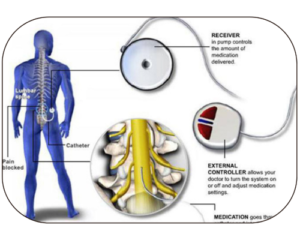
Welcome to Dr. Murali’s Pain Centre, where we specialize in delivering relief and improving the quality of life for individuals suffering from chronic pain. With a commitment to compassionate care and cutting-edge treatments, our dedicated team led by Dr. Murali is here to empower you on your journey towards a pain-free and fulfilling life.

What Is Inthratecal Morphine Pump?
An intrathecal morphine pump, also known as an intrathecal drug delivery system or intrathecal pain pump, is a medical device used to manage severe chronic pain. This implantable device delivers a controlled and consistent dose of morphine or other medications directly into the intrathecal space, which is the space surrounding the spinal cord. The intrathecal space is a preferred site for pain medication delivery as it allows for a lower dose of medication to be effective while minimizing potential side effects associated with systemic (oral or intravenous) administration.
Indications
- Chronic Pain Management
- Severe Chronic Non-Cancer Pain
- Avoidance of Systemic Side Effects
- Spinal Cord Injury-Related Pain
- Neuropathic Pain
- Reduction of Oral Opioid Dependence
Contra Indications
Injections are generally avoided in patients who have a systemic illness or skin infection over the puncture site, bleeding problems or coagulopathy, or an allergy to local anaesthetics or any of the drugs that will be administered.
Complications
The use of an intrathecal morphine pump for pain management, while effective in many cases, is associated with potential complications. Implanting and maintaining the pump require careful consideration of the risks involved. Complications may include infection at the pump or catheter site, which can lead to serious systemic infections or meningitis. Additionally, there is a risk of catheter or pump malfunction, resulting in inadequate pain control or overdose.
Post Procedure
Following the implantation of an intrathecal morphine pump, patients enter a post-procedural phase that involves close monitoring and specific care considerations. Typically, individuals are observed in a recovery area before being moved to a regular hospital room. Pain management and vital signs are closely monitored during this time to ensure patient comfort and safety.
